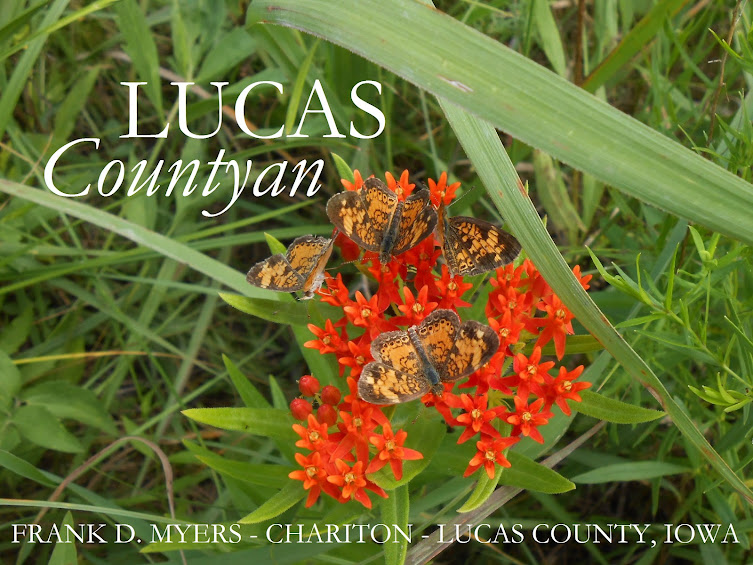William Spurling had lived 63 years in the south of Iowa when he died at the age of 77 in 1914 --- 21 on a farm near Melrose, 21 on a farm southeast of Russell and 21 in Russell. That's his tombstone at left in the Russell Cemetery (thanks, Find a Grave).
Age 14 when he "landed," his knowledge of regional history was first-hand and extensive so we can be grateful that he shared a few paragraphs of it with The Chariton Herald, published as follows in its edition of Feb. 19, 1903:
+++
Mr. William Spurling, of Russell, is one of the earliest settlers in this part of Iowa, and he has kindly related for the Herald some of the memories of the first years he spent in this part of the state. He says ---
My first recollections of early days in Iowa, in 1850, were in Monroe county, two miles north of where Melrose now is. The town then consisted of a lone cabin, occupied by John Goldsberry, with a spring nearby. The same fall, it was sold to Amos Brown.
The first person I saw after "landing" was Philo Prather, then a beardless boy of 19 or 20. We made a claim within one mile of the now town of Melrose, and went to work to build a house. My father started me out to invite hands in to raise it, and it took me two days to find enough. Two of the men are here now, John and Philo Prather. John Prather was justice of the peace. He married Alonzo Williams and Ellen Martin, but they did not agree and separated. He (John) said it was not his fault, but he never wanted that office again.
Your old people will remember the wet season of 1851, and especially the 22nd of May. I summered at Lagrange and worked there. Some people thought I didn't work, but I drew six dollars every thirty days just the same. There were ten families within ten miles --- eight in the timber and two on the prairie. The first preacher we had was old Bobby Coles, of Chariton, of the Lagrange circuit. He traveled 85 miles to make the round trip.
In the year 1852 there was an Irish boy, William Irvine, landed in our neighborhood. I met him the next day after his arrival at the Amos Brown home, and met him several times afterward. Mr. Brown had a daughter, and I asked her, "What does this mean?" She said, "You don't think I want an Irishman, do you?" But in few days she told me she didn't want a Hoosier either. Spurling and Irvine both live in Russell now.
In 1853, I went to Indiana, and the next year came back, bringing three families of Graves and Mrs. Jones. In 1851, Noah Threlkeld came to Amos Brown's and stayed until he built a house. In 1854, the Gilberts, William and Wells, also Joe Youtsey came. In 1855, Wm. Bernard came and I sold him some rails for $8.25, the largest amount I evr had up to that time.
In 1856, John Currier came and built a mill at the new town of Melrose. In 1851, the nearest blacksmith show was at Chariton, twelve miles away.
There may be mistakes in this recollections, and if so, I will be glad to be corrected. (Herald 19 Feb 1903).
+++
A couple of other things become obvious while reading Mr. Spurling's account, including the fact that he had a well developed sense of humor.
Here's his obituary, as published in The Herald-Patriot of Jan. 19, 1914, which provides a few more insights into his life and character:
+++
William Spurling was born October 8th, 1836, at Azalia, Bartholomew county, Indiana, and died January 21st, 1914, aged seventy-seven years, three months and thirteen days.
He moved to near Melrose, Monroe county, Iowa, when fourteen years of age and had resided in this neighborhood for sixty-three years. For twenty-one years on the farm near Melrose, twenty-one years southeast of Russell, and twenty-one years in Russell, where he died.
He was married to Permelia Ball in 1856. She died in 1857. He was again married to Cordelia Brooks in 1859. She died in March of 1904 at Russell. To them ten children were born, Mrs. Ida Lutz of Chariton, who died December 14th, 1908; Cyrus of St. Paul, Minn.; Eva, Alice and Willis of Russell; Mrs. Della Adcock of Chariton; Albert of Towner, S. Dakota; and Charles, Bertha and Minetta, who died in infancy. Seven Lutz grandchildren and seven Adcock grandchildren also survive him.
He and his wife were members of the Christian church at LaGrange, Iowa, transferring their membership later to Russell. He joined the Odd-Fellows order in early war days. The fact that he joined no other secret order, his fifty years of membership, and his expressed wish to be buried by the I.O.O.F. speak to his regard for that order.
Funeral services were conducted at the Christian church on January 24th by Rev. Shipman. The Odd Fellows impressive service was performed at the cemetery.
Mr. Spurling was of a cheerful and optimistic disposition. Had he troubles he kept them from others. He was always looking for the sunshine and not the clouds of life. He was on the lookout for the good in people rather than their faults. He was a home lover and a home maker, temperate and frugal in all things, and he died as he had lived, quietly and peacefully.







































